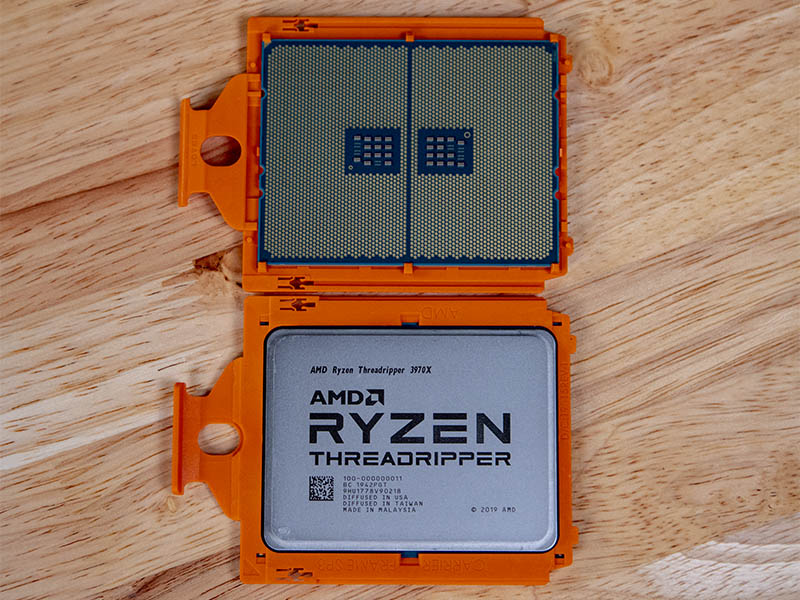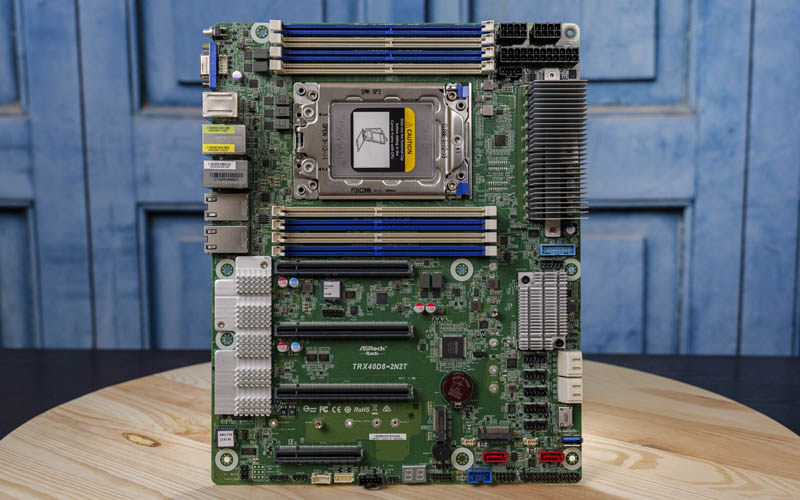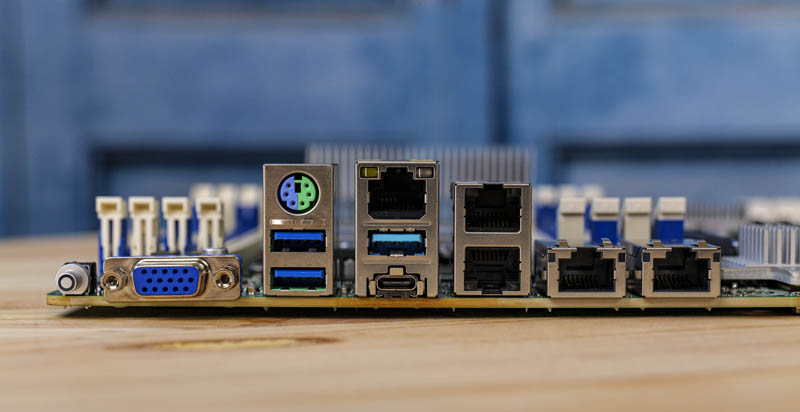ASRock Rack TRX40D8-2N2T Power Consumption
Power consumption can vary a significant amount depending on processors used and the number of HDDs/SSDs/Expansion cards used. Here we test just a primary system with a midrange NVIDIA RTX 2080 Super card installed in a PCIe Gen4 slot. Power is measured at the wall and the graphics card and SSD were not stress tested. Here is a sample of what we saw with the three different CPUs on 120V power:
- 3990X Idle: 144W
- 3990X Load: 606W
- 3970X Idle: 139W
- 3970X Load: 447W
- 3960X Idle: 139W
- 3960X Load: 442W
These are in-line but a bit higher than what we saw on some of the consumer platforms. To us, that makes sense. These have higher-end networking as well as the ASpeed AST2500 BMC onboard that are using extra power. Still, these are relatively close to what we saw in our consumer platform reviews so they make sense. They are also higher than we typically see on the server-side, although we usually cannot add a GPU in those systems. We had to make a call to make the test platform align more closely with what we used for the previous Threadripper work or the EPYC work, and we chose to align with workstation testing since the PCIe Gen4 slots are a major feature and we can see this solution being used with one or more GPUs often.
ASRock Rack TRX40D8-2N2T Market Impact
Perhaps the most intriguing but about this solution is that one can use relatively high-clock speed CPUs for a relatively low price.
When looking at the AMD Ryzen Threadripper 3990X, this may actually be the least attractive solution. With 64 cores many will want more than 8x 32GB for 256GB of RAM. Instead, the AMD EPYC 7702P is only a bit more costly. One trades lower clock speeds for more memory channels and bandwidth. One also gets a full set of PCIe lanes. The easy way to put it is that one does sacrifice platform expandability and performance for CPU performance.

The story changes a bit with the Threadripper 3970X. With that SKU, we have a 32 core processor with 4-channel memory. It is somewhat analogous to the AMD EPYC 7D12 which is an off-roadmap 32 core part from AMD. Here though, AMD EPYC 7502P is simply not as fast in many non-memory bound workloads. Again, we have the PCIe and memory expansion limitations, but they are less acute than they might be with 64 cores.
We still want a desktop version of the AMD EPYC 7H12. We will have a review of those chips in the very near future. By not releasing a high-clock speed 280W EPYC part for workstations, it leaves room in the market for solutions such as the TRX40D8-2N2T.
There is also relatively limited support. For example, we are unlikely to see this solution certified by VMware or for Windows Server, so support options there are limited. For the target market, that is unlikely to be a big deal. We still need to point it out since that is something that can limit the appeal.
With all of that said, for those who want something unique in their dedicated hosting clusters, or simply to run CPU-based render farms, the combination of the various Threadripper CPUs with the TRX40D8-2N2T will likely be a game-changer. A key challenge is the manageability of the Threadripper platform which is exactly what the TRX40D8-2N2T addresses.
Final Words
Something must be said for innovation here. At STH, we can completely see the desire to put Threadripper into servers. It is not 100% of the server market that would consider this an ideal solution, but it is likely enough of a niche out there that has been desiring the same thing since Threadripper launched.

ASRock Rack did an excellent job with the TRX40D8-2N2T. One can see design challenges that were overcome such as putting DIMM slots where a normal ATX chassis-motherboard standoff would be.

Little touches on the motherboard such as having three double-width PCIe Gen4 x16 slots plus an x8 slot, having NVMe storage options onboard including M.2 110mm for larger SSDs, but the networking stood out. ASRock Rack did not go with low-cost networking solutions. The choice of the Intel i225 plus Intel X710 was something we would not expect from this platform, but it was another bold design choice.
We did not get an official MSRP but street pricing seems to be around $700 USD. That is a slight premium over similar motherboards with higher-end networking solutions like the X710. An Intel X710-T2L network adapter alone retails for over $300 and that functionality is integrated here. We would have liked to have seen a lower price, but it something we understand given the market segment. Frankly, if you want to put a Threadripper 3990X, a $4000 CPU, in a server platform with lots of extra features, then the motherboard is going to cost more.
There is a certain audacity for ASRock Rack to even attempt a project like this, and it was clearly driven by customer demand. There is a segment of the market that wants the clock speeds of Threadripper and that does not need the platform expansion of EPYC, yet wants manageability. At STH, we applaud taking risks such as building a platform like this as it gives those who have unique infrastructure vision tools to build something different.




This motherboard would work also a workstation ? (with Windows sleeps and standby)
Good review.
“just” only 4 PCIe slots is a bit disappointing. Their previous model X399D8A-2T had 6 slots. NICs i255 + X710 is interesting.
Too bad AMD and Intel keep sticking to UDIMM.
It’s stupidly expensive memory, even on the second hand market.
Looks like a nice board though. Hope to one day consolidate my home servers to one box, but that will be RDIMMs for which CPU’s are very expensive.
weust, Intel is not sticking to UDIMM solely. Only their lowest Xeons are there (W-12xx). Once you get to W-22xx, you use (L)RDIMMs. The question is if you like to purchase slower CPU than competition and yet for way much more money. It’s basically RAM vs. cores/speed decision. Ignoring security bugs…
KarelG, security bugs is why I wouldn’t want Intel for now.
Sadly the Epyc CPU’s are too expensive for home use, afaik. I mean, I haven’t really looked but from what I’ve seen so far even the low core models are very expensive.
Right now my setup works, even though it mainly is Intel, so there is no need. Just a want.
With Threadripper Pro available Threadripper NON Pro needs to go back to its HEDT roost and stay there with its 4 memory channels and 64 PCIe 4.0 lanes. Threadripper Pro is the real workstation SKU and 8 memory channels and 128 PCIe 4.0 lanes and support for RDIMMs/Other ECC memory. Threadripper Pro is 2TB of memory support while Consumer Threadripper is only 256MB of memory capacity limited.
If one is using a lot of expensive ECC memory then having 8 memory channels and the possibility of 16 DIMM slots, at 2 DIMM slots per channel, presents a load more memory population options where one can purchase more of the lower cost/lower capacity ECC DIMMs and populate the MB with a larger amount of memory that way.
Used ECC Reg RAMs are way cheaper than ECC Unbuf RAMs and EPYC was sold at cheap price by HPE upgrade parts, so I choose EPYC over Threadripper for price.
https://forums.servethehome.com/index.php?threads/amd-epyc-rome-cpu-via-hpe-upgrade-very-cheap.26877/
“.. we also have a project coming using this motherboard and a passive cooler”; hopefully the project will use a cooler that will fit within a server chassis.
For 1/2 U chassis we will be trying the Dynatron L18 AIO CPU Cooler, it’s rated for the 3rd gen Threadrippers, so will be interesting to see how it handles our 3D rendering
Bought this board with a 3960X. System: four 32gb dimms, one ssd, five fans, no discrete video card.
Idle: 95W
Maximum observed power draw (prime95 blend): 311/314W, using two different power meters, one of which is a Fluke.
I dunno how you got 442W.. May you investigate a bit about that?
How many SATA drives will the BIOS correctly enumerate? Sadly, I have found that MB manufacturers fail to publish this parameter which is crucial in some server configurations. For example, 20 is a typical number, and that may be insufficient for a storage server.
I just bought this board and am having trouble enabling XMP. After enabling the system won’t POST and I have to clear CMOS to get it back. The XMP profile for this RAM is 3600mhz and 1.35v. Has anyone tried enabling XMP on this board? I reached out to Asrock just now. I’ll probably hear back from them tomorrow.